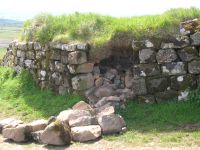Looking After Hadrian's Wall
Visitors to Hadrian's Wall this summer may see parts of the ancient structure being carefully taken apart, and then very carefully rebuilt.
This is part of a project which will also improve access to the Wall at several other locations and provide new signage and interpretation to help attract more visitors to explore the Roman frontier, thanks to a grant of £537,185 from the SITA Trust.
Detailed survey work began in June and the full project will be completed in October. Some of the sections of wall being conserved are currently on English Heritage's Heritage at Risk register.
Conservation work is now taking place at Great Chesters. We are working with Mr Willie Woodman of Great Chesters Farm to conserve and consolidate the wall on the Farm. The team will be on site for the next couple of months and will be a great opportunity for visitors to see conservation work taking place. Hadrian’s Wall on the farm is still used as a field wall and needs to be stock proof for cattle and sheep. In conjunction with the conservation work on the Wall the walling team will be ensuring that the Wall is stock proof without disturbing the important archaeology of this iconic monument.
 Sections at Burtholme Beck and Port Carlisle are next on the list. Work between Housesteads and Peel Crags, called the Clayton Wall after Victorian landowner John Clayton, has already been completed.
Sections at Burtholme Beck and Port Carlisle are next on the list. Work between Housesteads and Peel Crags, called the Clayton Wall after Victorian landowner John Clayton, has already been completed.
Andrew Saunders from SITA Trust said: "It's fantastic to see the work that has been done so far and more work in progress to conserve this part of the world heritage site for future generations.
"We hope that this significant grant will also encourage other funders to come forward to support Hadrian's Wall, ultimately removing all sections from the Heritage at Risk register."
Gary Simpson, director of Heritage Consolidation said: "All the work we are doing is by hand, using traditional methods and lime and sand mortar which allows the stone to breathe and is more flexible than cement.
"Any new stones we use have an obviously different colour to make sure that they are distinct from the Roman stones."
As Hadrian’s Wall is a scheduled ancient monument a plan for work on each part of each section of wall has to be approved by English Heritage before any work can begin.
One of the challenges is transporting materials to the sites over archaeologically sensitive surrounding areas, so the team is taking small loads more often to reduce weight.
Each section being repaired is being fully documented and GPS technology is being used to record exact locations, so future generations will know exactly what has been done where.
Help Us Look after the Wall
Over 3million people visit Hadrian's Wall each year. Protecting the archaeology, maintaining the National Trail, the landscape, and coordinating the management of access, communications, interpretation, transport and the environment is an increasingly difficult and expensive task in a challenging financial environment.
Like many World Heritage Sites, we face the constant challenge of meeting the increasing costs of providing the necessary care and protection that will help us ensure that people visiting today and future generations continue to enjoy and be inspired by the Wall.


.gif)


 button to add an item to your Itinerary basket.
button to add an item to your Itinerary basket.
